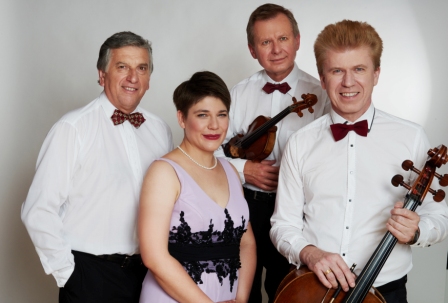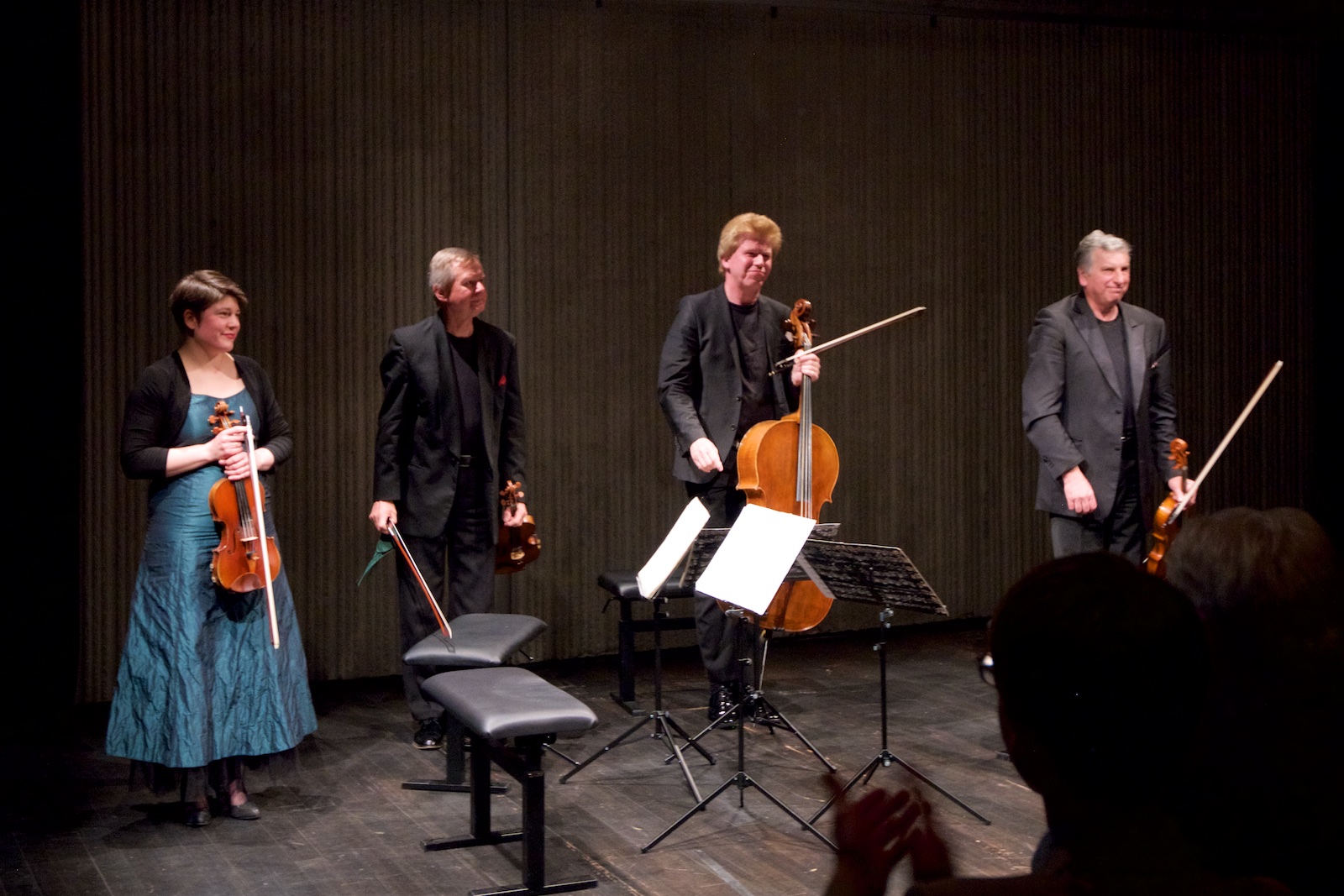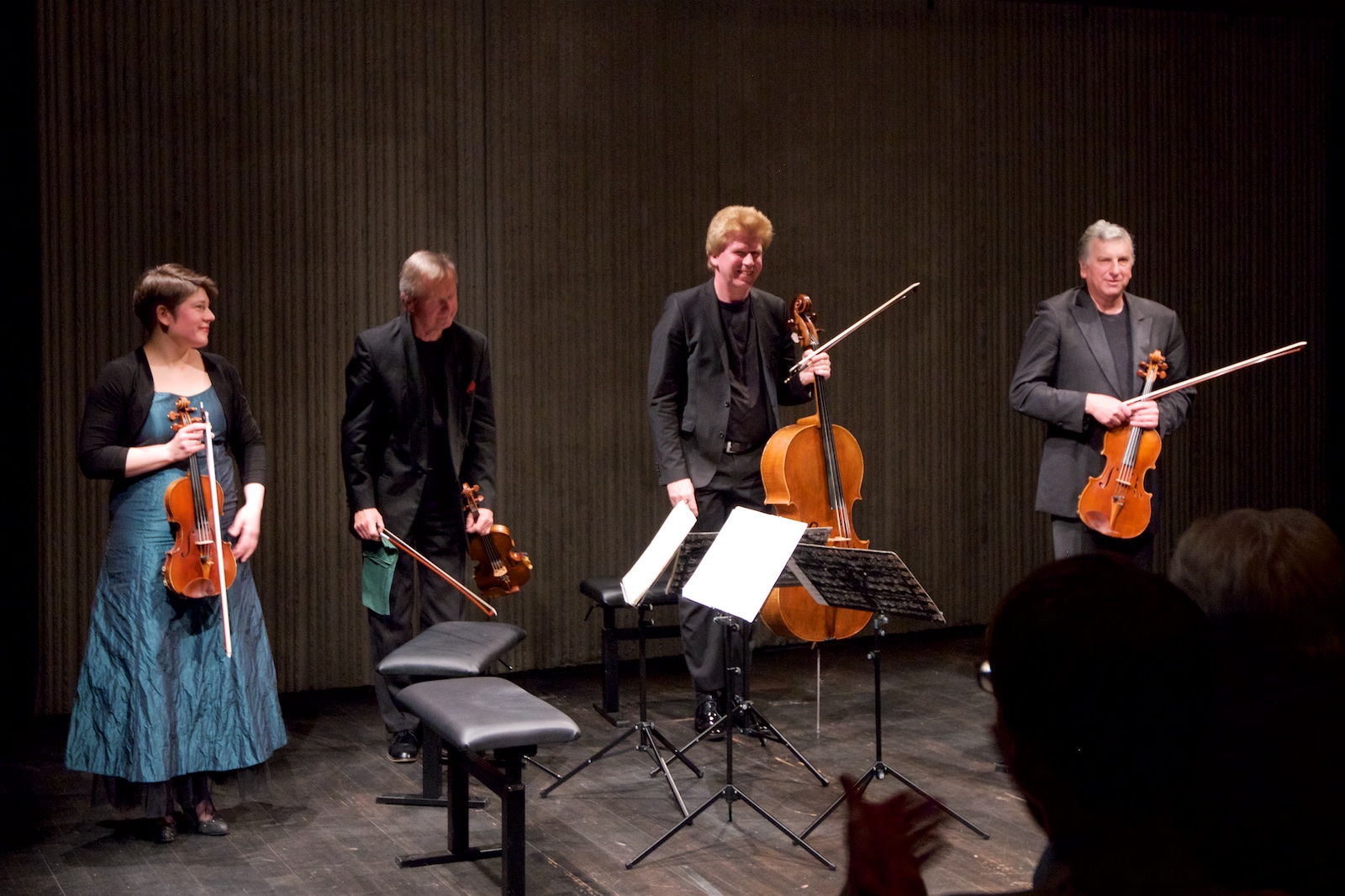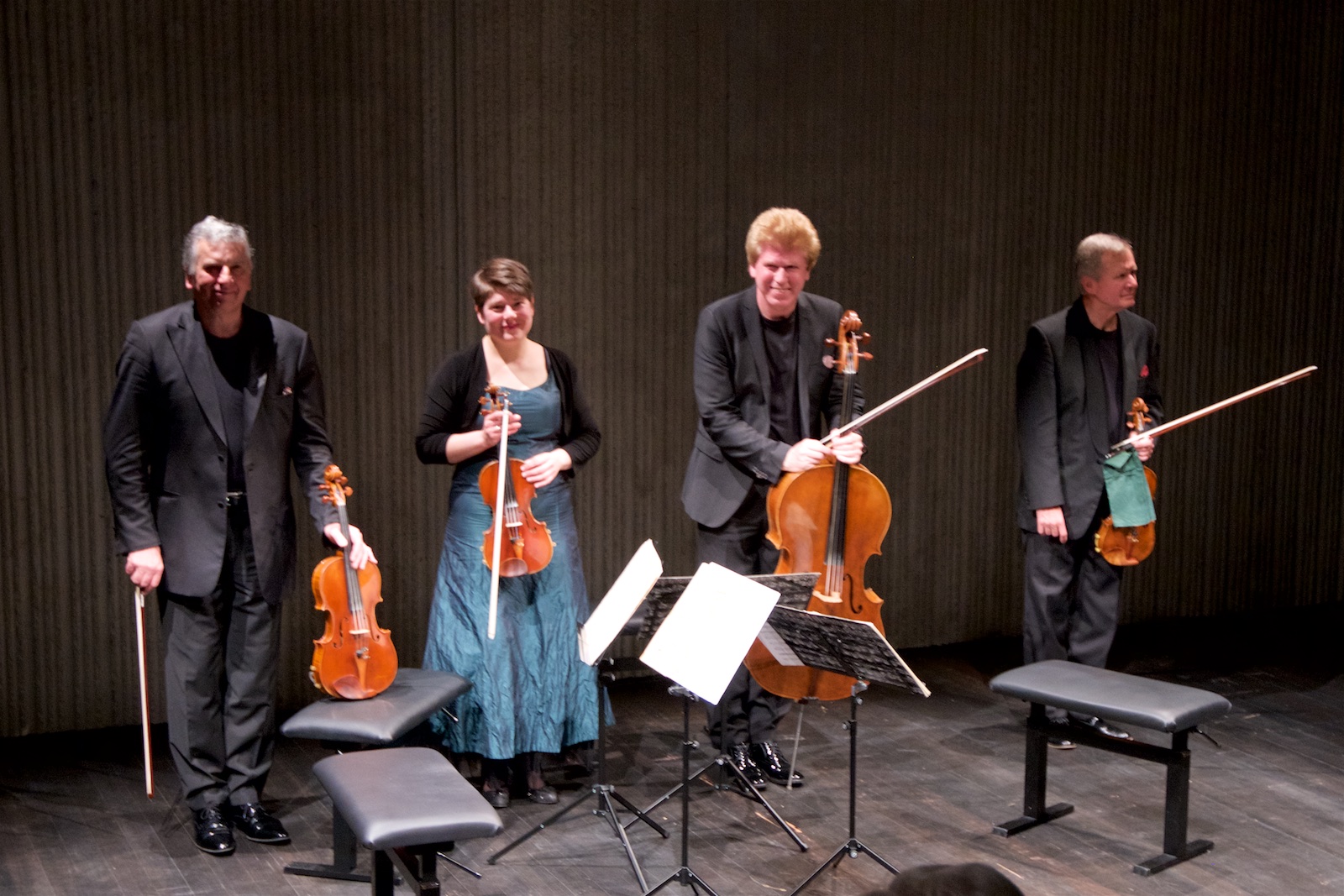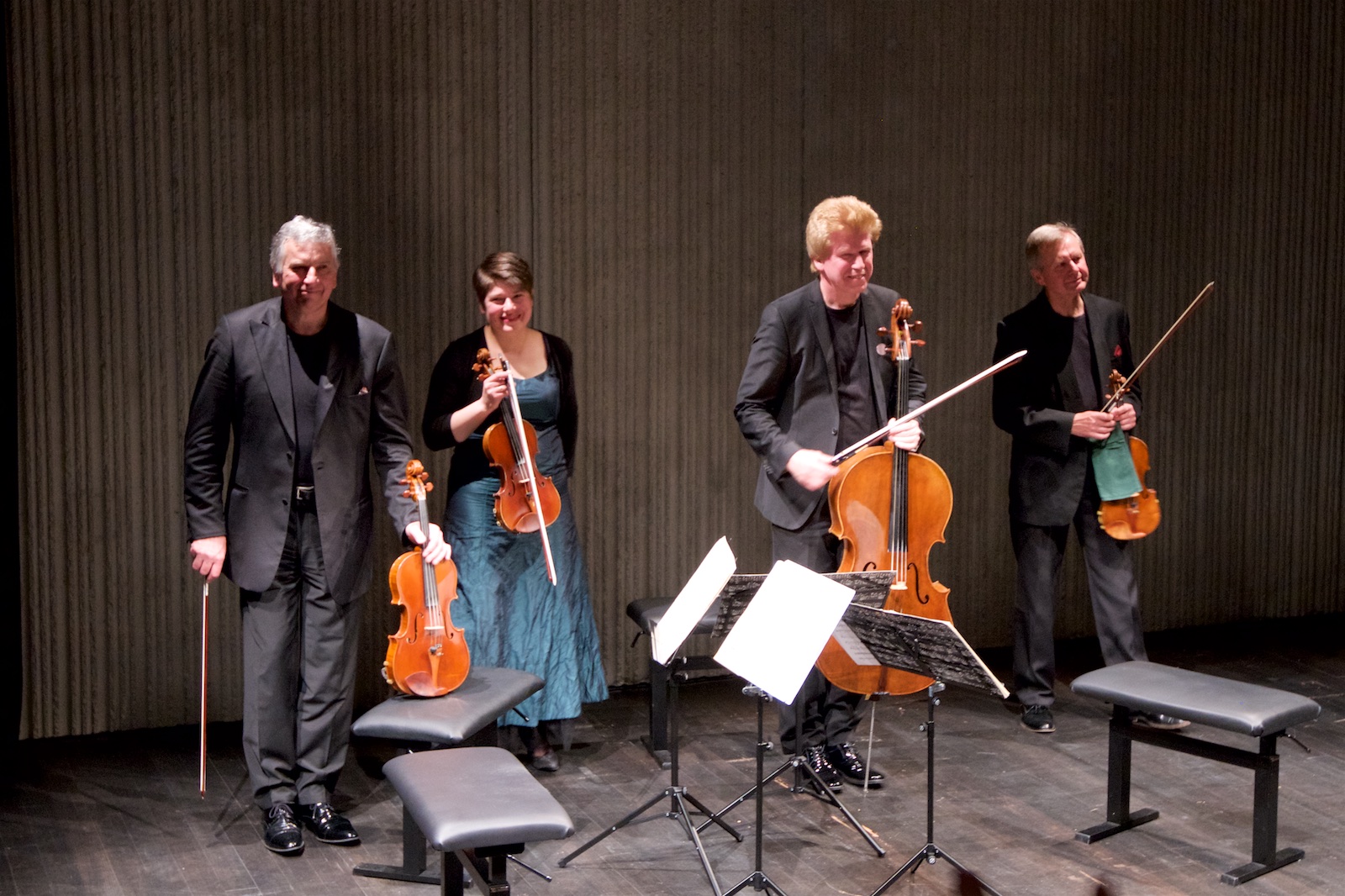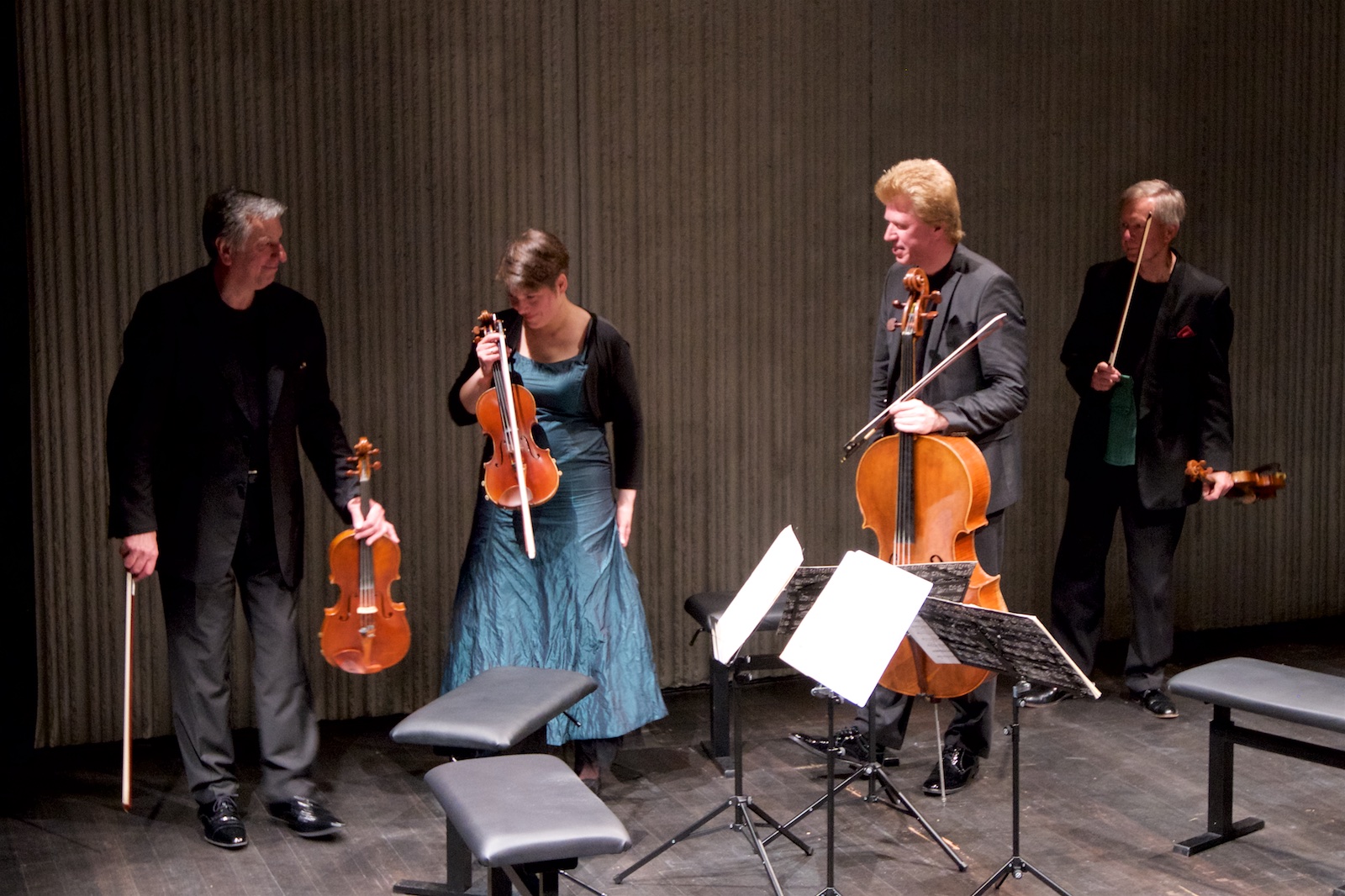Pražák Quartet
Webern / Schönberg / Smetana
Lugano, LAC / Teatrostudio, 2018-04-21

2018-04-30 — Original posting
Lebendige Volksnähe und wiedergewonnene Harmonie: Das Pražák Quartett in Lugano — Zusammenfassung
Das Pražák Quartett tritt mit einer neuen Primaria zu einer zweiten Karriere an. Es präsentierte wenig gespielte, romantische Frühwerke von Webern und Schönberg. Von Anton Webern den Langsamen Satz von 1905, von Arnold Schönberg das Streichquartett in D-dur von 1897. Danach wandte sich das Ensemble dem tschechischen Nationalkomponisten Friedrich Smetana, mit dessen Streichquartett Nr.1 in e-moll, “Aus meinem Leben”. Vom gleichen Komponisten stammten auch die Zugaben: zwei Sätze aus dem Streichquartett Nr.2 in d-moll. Erwartungsgemäß fielen die Kompositionen von Smetana am überzeugendsten aus. Dieses waren auch die Werke, in welchen die zwei verbleibenden Gründungsmitglieder des Quartetts am ehesten zu einem eigenständigen Beitrag fanden.
Table of Contents
Introduction
The Czech Pražák Quartet (see also Wikipedia) emerged in 1972, at the Prague Conservatory. For the following 38 years, the ensemble worked with the founding members, except that in 1986, Josef Pražák, the original cellist and co-founder of the quartet, left for health reasons. The ensemble had a very successful career as one of the foremost Czech string quartets. In 2010, the initial first violinist, Václav Remeš, left the ensemble, also for health reasons. In his place, Pavel Hůla (age-wise in the same league as the other members) stepped in, for five more years. With his departure in 2015, the substantially younger violinist Jana Vonášková-Nováková took over the seat of the first violinist. The quartet now has the following members:
- Jana Vonášková-Nováková, violin (since 2015)
- Vlastimil Holek, violin (founding member, since 1972)
- Josef Klusoň, viola (founding member, since 1972)
- Michal Kaňka, cello (since 1986)
A New Start
The transition from Pavel Hůla to Jana Vonášková-Nováková at the first violin was a major change for the ensemble. Other ensembles have failed at this. For example, the Alban Berg Quartett made a very similar step with a much younger violist, and after three years they decided to disband the ensemble. Other quartets never reached the original level of musicianship again after such changes.
However, these artists obviously decided to seize this chance, and to make a serious effort for a fresh start. The ensemble retreated for two full years, in order to re-learn the core repertoire. In 2017, they launched a new career on international stages. To me, the two-year retreat is a clear indication for the seriousness of the restart.
Venue, Program
For this program at the Teatrostudio within the LAC (Lugano Arte e Cultura) in Lugano, the Pražák Quartet presented a late-romantic program with early compositions by Webern and Schönberg, and finally, a centerpiece of the Czech repertoire, the Quartet No.1, “From my life”, by Bedřich Smetana.
I doubt that this concert was a commercial success for the organizers. The venue is small to start with, offering at most space for around 100 visitors. For this concert, there were around 60 chairs—and the audience was around 40 only, clearly less than in the concert on the previous day. The nice weather could have been a reason for not attending.
More likely, though, people may have been afraid of attending a concert with dodecaphonic music from the Second Viennese School. However, nothing could have been more wrong than this. The compositions by Webern and Schönberg are truly romantic works from earliest periods in these composers’ productive life: both could just as well have been by Robert Schumann (1810 – 1856) or by Johannes Brahms (1833 – 1897): euphony in its purest form!
Interactions
How artists interact (or don’t interact) with the audience, as well as how they interact among themselves, can be a key factor in how the concertgoers perceive a performance.
This starts with how the ensemble arranges itself on the podium / the stage. Interestingly, in the placement, it was not the first violinist, Jana Vonášková-Nováková, who was given a special placement within the group. Rather, it was the violist, Josef Klusoň, somewhat isolated on the rightmost seat, turned inward, partly looking away from the audience, his instrument facing the back wall. His visual contacts mostly pointed towards his diagonal opponent at the second violin, Vlastimil Holek, the other founding member. The latter seemed rather introverted, was partly hidden behind the first violinist.
In contrast, Michal Kaňka at the cello seemed to occupy the center of the ensemble, in the rear. The “center impression” wasn’t just because the instrument and his arms required more space than with a violin or a viola. Rather, also Kaňka’s extroverted personality, his vivid, engaged, enthusiastic gestures and facial expressions often made him the “center of the action”. He was openly communicating with the entire team, through body language and facial mimics. Occasionally, he even seemed to talk to himself.
The audience saw very little of the friendly, open facial mimics of the primaria, Jana Vonášková-Nováková, as her visual interaction was mostly oriented towards the cellist.
Acoustic Impressions
Naturally, from the pitch and the precedence in the compositions, the first violin was typically dominating, at least to a certain degree. But with this ensemble, the cello wasn’t ranking far behind the first violin. Often, in the playing, the impulses primarily seemed to originate from the cello. Most often, the second violin took a secondary role, stayed in background, acoustically. Finally, the viola initially seemed somewhat at an acoustic disadvantage.
It wasn’t until the second half of the concert, when the quartet by Smetana gave Josef Klusoň a good chance to show the qualities of his instrument and his playing, together with the second violinist, Vlastimil Holek. In the Smetana quartet, the two middle voices appeared to liven up in folk-like melodies, forming a harmonious duo.
Overall, my impression was that the strength of the ensemble isn’t so much in polished sound or instrumental perfection. Rather, it is in the artists’ ability to gather and reproduce the mood, the atmosphere of a composition. And, in particular, the Prazák Quartet exhibited a strong side in music by the Czech national composers, here Bedřich Smetana. I’m sure this also extends to music by Antonín Dvořák (1841 – 1904).
Webern: Langsamer Satz for String Quartet, WoO 6
Anton Webern (1883 – 1945), produced various works for string quartet. Only few were deemed important / valid enough to receive an opus number:
- Five Movements for string quartet, op.5 (1909),
- Six Bagatelles for string quartet, op.9 (1913), and
- String Quartet, op.28 (1937 – 1938)
Besides these works, there is a string quartet from 1905, plus some fragments and individual movements. The most well-known among these is the Langsamer Satz (slow movement) for String Quartet, WoO 6 from 1905. Webern wrote this while he was a pupil to Arnold Schönberg (1874 – 1951). He apparently took Schönberg’s composition Verklärte Nacht (transfigured night), op.4, from 1899, as a model for this single movement.
The Performance
For those scared of dodecaphony: this definitely isn’t! Rather, it is harmoniously flowing, romantic music, very clearly inspired by Verklärte Nacht by the composer’s teacher (see above). The Pražák Quartet gave a very expressive rendition of this composition: a dense, warm, romantic soundscape, with freely swaying vibrato, frequent use of portamento, and with lush dynamics.
Rating: ★★★
Schönberg: String Quartet in D major
Arnold Schönberg (1874 – 1951) composed four “regular” string quartets:
- No.1 in D minor, op.7 (1905)
- No.2 in F♯ minor, op.10 (1908)
- No.3, op.30 (1927)
- No.4, op.37 (1936)
In addition, besides a number of fragments, there are several works for string quartet that were not published during the composer’s lifetime, such as the String Quartet in D major from 1897. This is Schönberg’s first major composition, featuring four movements:
- Allegro molto
- Intermezzo: Andantino grazioso
- Theme and Variations: Andante con moto
- Allegro
For the composition of this work, Schönberg received advice from his friend, composer, conductor and teacher Alexander von Zemlinsky (1871 – 1942). The latter also showed a draft of the quartet to Brahms, who gave his approval to the composition. So, the link to Brahms mentioned above is fully justified: Schönberg very much admired Brahms as a composer.
The Performance
I. Allegro molto
The quartet opens with a happy, joyful movement. The Pražáks played it lively, not sporty, though, but with subtle agogic play and very harmonious transitions. I did not see this as exceedingly “technical” or analytical interpretation. The performance certainly was expressive, emotional, not cold / cool.
II. Intermezzo: Andantino grazioso
With its con sordino playing, this movement was a play with colors. The artists showed familiarity with the composition, feeling “at home” in this music. With that, they could focus on phrasing and dynamics, on forming harmonious arches. Was it just my impression that the first violin occasionally played a tiny bit low?
III. Theme and Variations: Andante con moto
A theme with five variations: a movement that seems inspired by Beethoven and Schubert, if not by baroque forms such as canon and fugue. Especially in the last variations, the middle voices (the founding members, after all!) had an opportunity for subtle duo playing, while—as an exception—the first violin and the cello assumed accompanying function.
IV. Allegro
Just like the first movement, the last one opens with a fanfare in unison: a jolly, joyful, even boisterous movement, full of momentum, not far from a folk dance. Here, the cellist (Michal Kaňka) clearly was in control of the performance.
Rating: ★★★
Smetana: String Quartet No.1 in E minor, JB 1:105, “From My Life”
The popularity of the Czech composer Bedřich Smetana (1824 – 1884) mostly stems from his orchestral works, and from his operas. He only produced very few chamber music works:
- Fantasia for violin and piano, JB 1:12 (1843)
- Piano Trio in G minor, JB 1:64 (1855)
- String Quartet No.1 in E minor, JB 1:105, “From My Life” (1876)
- Duet for Violin and Piano, JB 1:118, “From my Homeland” (1879 – 1880)
- String Quartet No.2 in D minor, JB 1:124 (1882 – 1883)
The String Quartet No.1 in E minor, “Z mého života” (From My Life) is one of the very central works within the Czech chamber music repertoire (and beyond). It features four movements:
- Allegro vivo appassionato
- Allegro moderato à la Polka
- Largo sostenuto
- Vivace — Meno presto — Moderato — Allegro — Meno
The significance of this composition is in the composer’s biography: by 1876, Smetana had become deaf, but was still hoping that this disability would not be permanent. In this string quartet, the composer contemplates his past life: his ideals (movement I), happy memories (movement II), adversities and finding harmony in life (movement III). On movement IV, the Wikipedia article quotes from the score: “describes the journey that led to an understanding of the true essence of national art, only to be interrupted by the catastrophe of his incipient deafness. The end is almost resigned, with only a small ray of hope for a better future.“
The Performance
Finally, with the quartet by Smetana, the Pražák Quartet was truly in its element, in its “home turf”:
I. Allegro vivo appassionato
Already three bars into the first movement, the viola starts an extended, expressive solo. With this, all of a sudden, the special placement of Josef Klusoň on the podium seemed to make sense. Throughout the movement, the viola retains a prominent role and function. However, with all the passion, the ardor, the expression in this movement, the viola never sounds aggressive.
II. Allegro moderato à la Polka
More than the first movement, the à la Polka can serve as an example for the specific agogics and the rubato that are so typical for Czech folk music. And in the interpretation by the Pražák Quartet showed this in an exemplary way: an enthralling performance, with segments full of momentum. At the same time, there were also sections were relaxed dance rhythms prevailed. However, even in those, the ensemble, managed not to drop the tension (and the attention).
Also in this movement, the viola has a key role: first in the section starting at bar 39, where the viola part has the annotation Solo, quasi tromba, sul G (like a trombone). More so even later again in the Più Allegro section, in a similar solo starting in bar 160, which launches the build-up to the climax. Here, Josef Klusoň started the acceleration, seemed to give the decisive impulses for the ensemble.
The subsequent Meno mosso almost felt like somewhat of a caricature. This leads into a final, emotional Più mosso climax. In the heat and the excitement, the first violin missed the culminating peak note just prior to the final cadence. I think that Jana Vonášková was as much shocked about the incident as her companions, as well as the audience. The cellist’s facial expression spoke volumes, as he seemed to break out into silent self talk…
III. Largo sostenuto
…but the incident was instantly forgotten about, when Michal Kaňka at the cello opened the subsequent Largo sostenuto with an eloquent, elegiac and expressive recitative. Throughout this slow movement, the cello frequently had the role of a pacemaker (besides the first violin), forming an expressive basis through the often changing moods in this movement. I noted the strongly emphatic playing, the alternations in drive momentum: calm cadenzas full of expectation, forceful, confirming sforzato chords. Certainly, never in this movement, the music lost its tension and intensity!
IV. Vivace — Meno presto — Moderato — Allegro — Meno
The ensemble presented the jubilant, emphatic first part as a joint effort, uniting its forces for an interpretation full of joy and glory. The performance wasn’t highly polished or aiming at perfection in sound and intonation, rather, it was the expression, the emotion that counted. Smetana lets the viola and both violins contribute equally to this music.
As outlined above, however, the movement does not remain in this joyful mood: after a frightening general rest, the catastrophe of painful deafness sets in, with the Meno presto: one could really feel the composer’s pain and despair! Luckily, this only lasts 21 bars: the ending seems to indicate a reconciliation with fate—or is it resignation? Not atypical for this quartet, the viola retains the (almost) “last word”: it seems that here, Smetana laid a special focus on this instrument.
Rating: ★★★½
Encores — Smetana: 2 Movements from String Quartet No.2 in D minor, JB 1:124
The Pražák Quartet offered two encores, both from the String Quartet No.2 in D minor, JB 1:124, which Bedřich Smetana composed in 1882, after completing his famous cycle of symphonic poems “Má vlast” (see also above for a note on Smetana’s chamber music oeuvre). With this, the ensemble stayed within its “home turf”: repertoire on which the quartet has built its reputation. The four movements of Smetana’s second string quartet are
- Allegro
- Allegro moderato
- Allegro non più moderato, ma agitato e con fuoco
- Finale: Presto
Highlighting indicates the two movements selected as encores.
The Performance
II. Allegro moderato
Albeit the movement is harmonically more advanced, often dissonant, the Pražák Quartet managed to retain the folk dance character in this music. They clearly enjoyed all the ritenuti in the dance parts, without neglecting the serene, calm even pensive segments in this Scherzo-like movement. Interestingly, the movement does not end with a furious stretto: rather, the dance rhythm calms down, comes to a gentle stop. It’s music obviously very close to these artist’s heart!
IV. Finale: Presto
A rhythmically poignant movement, with strong, almost extreme rubato—again obviously related to folk music, folk dance. It’s a true Finale with a short, but vehement, furious stretto ending. An excellent way to close this concert!
Rating: ★★★½
Conclusions
Almost inevitably, I was comparing this concert with the one by the Belcea Quartet on the previous evening. Here’s what such a comparison boils down to. Sure, the Belcea Quartet offers more instrumental perfection, is technically more advanced, possibly more poignant in its performance, its dynamic range astounding. But they disappointed in their performance of Dvořák’s famous “American” String Quartet, which—to me—lacked the folk / dance character.
Here it was the contrary: the performance was less than perfect, but the artists are clearly more “at home” with the Czech national composer(s). With this music (here: Smetana), I definitely prefer a performance that retains the folk character, even if that goes at the expense of perfection.
Addendum
For the same concert, I have also written a (shorter) review in German for Bachtrack.com. This posting is not a translation of the Bachtrack review, the rights of which remain with Bachtrack.com. I created the German review using a subset of the notes taken during this concert. I wanted to enable my non-German speaking readers to read about my concert experience as well. Therefore, I have taken my original notes as a loose basis for this separate posting. I’m including additional material that is not present in the Bachtrack review.


